Debbie Young's Blog, page 9
July 19, 2023
In Praise of Second-hand Bookshops
This post about my love of second-hand bookshops was originally written for my publisher, Boldwood Books, to mark the publication of my latest novel, the eighth Sophie Sayers Cozy Mystery, Murder in the Highlands.
As an avid reader who reads across a wide range of genres, and especially fond of books from the mid-century or earlier, I cannot resist second-hand bookshops.
They provide a completely different customer experience from shops for new books, because the contents are unpredictable, and each shop offers unique stock. You never know what you might find, and that element of the unexpected adds a sense of adventure.
As well as selling cheap editions of modern bestsellers and timeless classics, they offer curiosities long out of print and old favourites in quaint editions. I always keep an eye open for books printed during paper rationing during the Second World War, for example, and am building up a good collection of vintage Lord Peter Wimsey mysteries by Dorothy L Sayers.
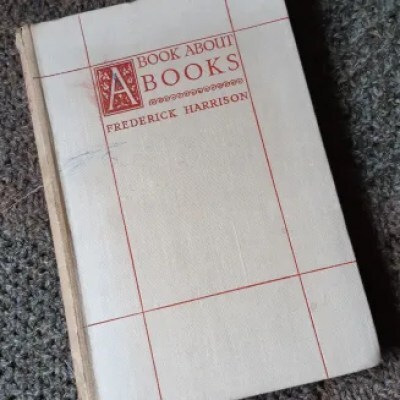 One of my collection of books printed during paper rationing during the Second World War – what a comfort read this must have been during those difficult times.
One of my collection of books printed during paper rationing during the Second World War – what a comfort read this must have been during those difficult times.I often buy vintage hardbacks for their dustjacket designs that I know will look beautiful on my bookshelves, whether or not I plan to read them.
Whenever I visit a second-hand bookshop, I keep an open mind. Rather than looking for books on my to-read list, I wander about waiting for something to call out to me. Often it’s a book I’d otherwise never have discovered, or a stunning edition of an old favourite I’ve never seen. One of my favourite finds is a collection of Sherlock Holmes stories entirely in Pitman’s Shorthand.
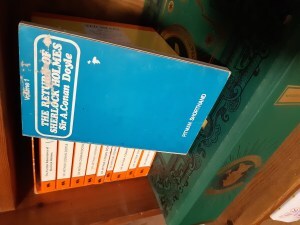 A quirky addition to my Sherlock Holmes collection
A quirky addition to my Sherlock Holmes collection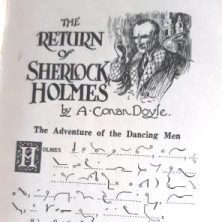 I think the code-loving Holmes would approve
I think the code-loving Holmes would approveI can’t read shorthand, but it was such a conversation piece that I had to have it.
It’s uncanny how often a book presents itself that’s relevant to a current interest. I also love any with intriguing inscriptions suggesting a fascinating back story, like the book of Gaelic poetry that Hector gifts to Sophie’s mum in Murder in the Highlands.
When I first heard about Leakey’s Bookshop in Inverness, I couldn’t wait to visit. Housed in a deconsecrated church near the banks of the River Ness, it’s one of the biggest second-hand bookshops in Scotland, shoehorning books into every possible space, including a gorgeous mezzanine gallery. The wood-burning stove blazing on the ground floor encourages customers to linger, and it would be easy to spend all day browsing its vast stock.
Although it hasn’t been a place of worship for half a century, there’s still a reverential hush as book lovers tread softly among the shelves. Each visit feels like a pilgrimage.
 The fabulous Leakey’s bookshop is one of my favourite places in Inverness, and Murder in the Highlands includes a fictionalised version, which of course Hector adores
The fabulous Leakey’s bookshop is one of my favourite places in Inverness, and Murder in the Highlands includes a fictionalised version, which of course Hector adoresI’ve invented a fictionalised equivalent of Leakey’s for Murder in the Highlands, to help Sophie lure Hector to Inverness to inspire him for his own planned second-hand department at Hector’s House. Little do they realise that the book of Gaelic poetry is also going to play a significant part in their Highland mystery… my latest novel, the eighth Sophie Sayers Cozy Mystery, Murder in the Highlands.
 In
Murder in the Highlands
, I send Sophie and Hector to some of my favourite places in the Scotland, including Loch Ness – although a crisis prevents them from reaching Urquhart Castle
In
Murder in the Highlands
, I send Sophie and Hector to some of my favourite places in the Scotland, including Loch Ness – although a crisis prevents them from reaching Urquhart CastleIt’s available on Amazon as an ebook, paperback, hardback and audiobook, with the ebook currently on special offer at just 99p. (If you’re a member of Amazon Prime, you can even read it for free!)
To order your copy via Amazon, click the image below . You can also order the ebook and audiobook from all the usual digital stores online, and the print editions from any of your favourite places to buy books, including traditional bookshops.
Meanwhile, Back in the Cotswolds…I’m now writing the ninth Sophie Sayers Cozy Mystery, set in the Cotswolds once more, and centring around Hector’s bookshop in the village of Wendlebury Barrow. Hector’s trusty Land Rover, pictured below, will play a crucial part in Driven to Murder! More news on that story soon…
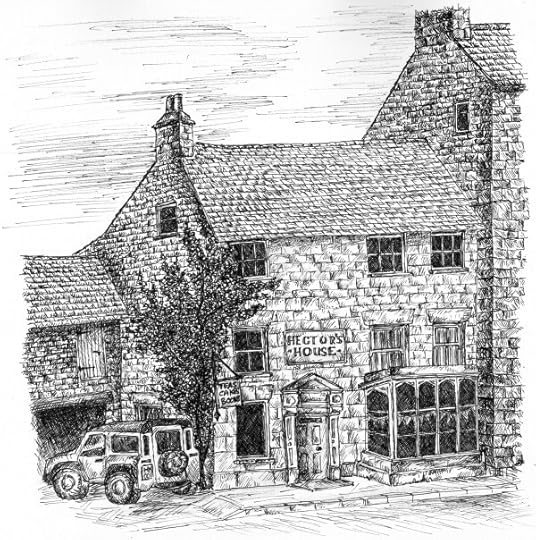 This illustration of the Hector’s House bookshop by Thomas Shepherd is in the same style as Sophie’s ficitious cottage (Copyright Thomas Shepherd http://www.teshepherd.art.com)
This illustration of the Hector’s House bookshop by Thomas Shepherd is in the same style as Sophie’s ficitious cottage (Copyright Thomas Shepherd http://www.teshepherd.art.com)
July 14, 2023
Set Sail for St Mary’s
This week on my blog, I’m looking forward to a jolly local event at my parish church, St Mary’s Hawkesbury. The active community life in my home village of Hawkesbury Upton provides me with an endless supply of story ideas for my light-hearted, humorous fiction set in the Cotswolds.
When Colin Dixon told me he’d booked the Port of Bristol Shanty Crew to sing at Church Farm House on Sunday 23rd July as part of the Friends of St Mary’s Summer Weekend, my first thought was, “But Hawkesbury is landlocked”.
My second thought was, “What exactly is a sea shanty anyway?”
The sea has inspired music for as long as man has been able to sing.
Perhaps in recent times the most popular song about the sea has been “La Mer”. First recorded by its composer Charles Trenet in 1946, it’s since been covered over 4,000 times, often in other languages, such as “Das Meer” (German), “De Zee” (Dutch), “Bla Hav” (Swedish), “Laulu merelle” (Finnish), and “Волна” (Russian).
The sea shanty gets its name from French word chanter (to sing), but unlike Trenet’s chanson, this musical form originally had a far more serious purpose than mere entertainment. Sea shanties were workmen’s songs, developed in the golden age of sail. They helped coordinate the sailors’ rhythmic, vigorous movements required to keep the ships under control – hoisting sails, hauling ropes, lifting anchor, and so on.
Sea shanties came in many forms, each to direct a specific kind of action, such as:
short draglong haulheavingpumpThe songs often comprised a call led by a shanty man who dictated the speed of the action, followed by a response from his team. Sea shanties were always sung a cappella, because no crew member could be spared to play an instrumental accompaniment for aesthetic effect. These songs were primarily functional.
Like marching songs for soldiers, sea shanties would keep sailors going in even the most challenging circumstances. They might also unite a team that had never worked together before, especially ramshackle crews assembled from harbourside pubs just before a ship sailed.
In time, sail gave way to steam. (Anyone else over a certain age humming “The Onedin Line” theme tune now? It’s Khachaturian’s “Adagio from Spartacus”, if you want to find it on Spotify).
As the nature of sailors’ work evolved, sea shanties ceased to be an essential soundtrack to their daily chores, and the songs passed into history and the archives of folk music collectors.
But recently they’ve been enjoying a revival via a surprising source. In 2020, a young Scottish postman, Nathan Evans, began sharing on Tiktok videos of himself singing sea shanties, starting with “Leave Her, Johnny”. His videos went viral and spawned a dedicated community of 21st century enthusiasts, #shantytok. They also earned Nathan Evans a recording contract with Polydor.
The Port of Bristol Shanty Crew was formed in February 2022 as part of this wave of revivalism. Its members may look like seasoned sea dogs, but their purpose, unlike their predecessors’, is purely to entertain. Nor do they only sing on board ship. Which is just as well, as it would be tricky to manoeuvre a tea clipper onto the lawn of Church Farm House.
 A seagull’s eye view of St Mary’s Hawkesbury and Church Farm House, from the top of Hawkesbury Knoll
A seagull’s eye view of St Mary’s Hawkesbury and Church Farm House, from the top of Hawkesbury KnollCome and join us there (no booking required – just turn up) on Sunday 23rd July between 2pm and 5pm. Free admission, and everyone welcome. Bring a picnic.
Sailor suits and grog optional.
(I originally wrote this post the July issue of the Hawkesbury Parish News – another great source of ideas for my fiction!)
IN OTHER NEWS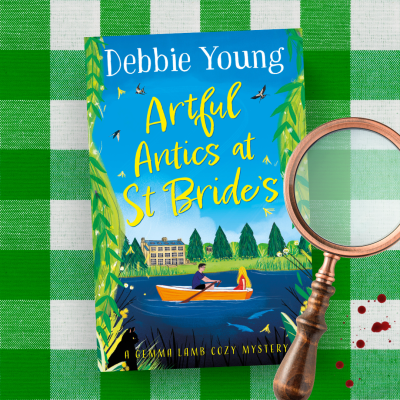 The St Mary’s Summer Weekend event is just one of many things keeping me busy just now. I’m also:
The St Mary’s Summer Weekend event is just one of many things keeping me busy just now. I’m also:
Fortunately, I’ve just finished teaching my third Simply Self-Publish course for Jericho Writers, which gives me a little more writing time – but they’re already taking bookings for the next course which runs October-December. If you’re an aspiring indie author who’d like to know more about how the course can help you, click here.
Finally, if you’d like to join my Readers’ Club to receive a monthly enewsletter and a link to download my free novelette The Pride of Peacocks, you can sign up here.
And if you’d like my publisher Boldwood Books to send you an occasional enewsletter with news of new books and special offers, click here.
Phew! Now I’m off for a restorative cup of tea!
July 5, 2023
Midsummer Method & Madness
This week, as the year reaches its halfway point, I’m taking stock of how I spend my time.
Halfway through the year, I begin to wonder whether I’m spending 2023 wisely. Then my author friend Clare Flynn sends me an article in Frost magazine in which Sue Moorcroft takes stock of her writing life. Sue lists all her activities under three pairs of headings:
things that make her happy/unhappythings that are good for her/bad for herthings that earn her money/don’tSeeing the facts in black and white empowers her to ditch several time-consuming tasks for good, freeing up more time for what makes her happy/healthy/solvent.
 I could do with some time-saving tips from the ever-efficient Moominmamma
I could do with some time-saving tips from the ever-efficient MoominmammaThis exercise will resonate with anyone who is neither immortal nor Croesus, eg me. I’m hoping that compiling my own lists will resolve my biggest problem: insufficient hours in the day.
I’m notoriously over-optimistic about how much I can cram into my waking hours. My current solution to chronic time-shortage is to cut down on sleep and ignore the housework, a strategy neither healthy nor sustainable.
To add nuance to my analysis, I highlight items that cost nothing. For example, reading is both enjoyable, good for me and – for now – free of charge. Guilty of what the Japanese call tsundoku (buying books but not reading them), I have enough unread books in my house to last me years, plus many old favourites I’d be glad to reread. Coupled with public library membership, I need never buy a book again.
Of course, I will buy more books – lots of them – but it’s good to know there’s no reason to curtail my favourite hobby.
Gardening, too, need cost nothing. There are always more weeds to pull than I have time for. Some are pretty and benefit wildlife. As American agricultural scientist George Washington Carver once said, “A weed is a flower growing in the wrong place.”
Instead of spending a fortune at garden centres or hours wrestling with horticultural interlopers, I just need to learn to love the weed.
In the end, only two candidates for banishment leap off the page – my dislike of a dirty house and my hatred of housework. But this is an easy fix. As Clare points out, I just need to hire a cleaner. The same day, my student daughter returns for the summer holidays and fills the vacancy. I feel as if I’ve won a trick in a game of Pairs.
I’d been hoping the exercise would uncover further opportunities to declutter my to-do list, but it seems I’ve already jettisoned from my life everything else I hate, such as commuting, ironing, and tumble-drying laundry.
Catching up on my sleep will have to remain a daydream.
So I set my list aside and press on with what I really intended to do when I sat down at my desk this morning: to write this column for the Tetbury Advertiser, an activity in the “good for me” and “makes me happy” columns.
And it didn’t cost me a bean. Result!
This post was first published as my Young By Name column in the July/August edition of the Tetbury Advertiser.
In Other NewsIf visiting historic Cotswold churches is on your “makes me happy/ good for me/costs nothing” lists, come and join me at St Mary’s, Hawkesbury on Saturday 22nd– Sunday 23rd July, to tour the church and try your hand at bellringing (another of my free/fun/healthy hobbies).
 A seagull’s eye view of St Mary’s Hawkesbury, from the top of Hawkesbury Knoll
A seagull’s eye view of St Mary’s Hawkesbury, from the top of Hawkesbury KnollOn the Sunday, you can also enjoy a free gig by the Port of Bristol Shanty Crew while you picnic on the lawn at nearby Church Farm House. For more information, please visit www.friendsofstmaryshawkesbury.com/events.
 Midsummer madness at St Mary’s this month: a free gig by the Port of Bristol Shanty Crew
Midsummer madness at St Mary’s this month: a free gig by the Port of Bristol Shanty Crew
June 28, 2023
When Life Imitates Art: Some Writers Share Their Experiences
In this post, I share the experiences of writers who have dreamed up novels which at least in part becomes reality true post-publication.
My process is the same every time I write a novel – and I’ve written 12 of them now – I start by jotting down ideas in a notebook.
Once they’ve had a chance to percolate in my unconscious, usually for many months, and sometimes fpr years, I wrestle the ideas into a rough outline of the plot. Then I begin to write, using the outline as a prompt, chapter by chapter, until I reach the end.
My outline is brief – a sentence or two per chapter – but I always know the main themes, the broad structure of the plot, the key characters and the timescale before I start. I add a couple of new characters each time to add interest, and each book is set at a specific time of year to add seasonal interest.
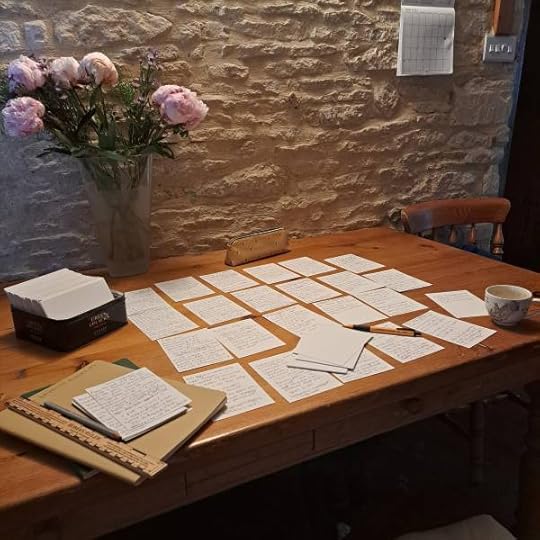 Stage 2 of the planning process for my new novel
Stage 2 of the planning process for my new novelMy stories are inspired by real life, but my characters and the plots are entirely fictitious – or so I thought, until I started writing my current work in progress, Driven to Murder (working title), the ninth Sophie Sayers village mystery. Sophie lives in the isolated Cotswold village of Wendlebury Barrow, where anyone who doesn’t drive depends on the local bus service.
[image error][image error]At the end of her previous adventure, Murder in the Highlands, Sophie and Hector made a pledge to each other: she will learn to drive if he learns to swim – two activities that play a crucial part in that novel’s plot.
At the start of the series, in Best Murder in Show, Sophie had made what some might consider a rash decision by moving to Wendlebury Barrow without being able to drive, and after living there for more than a year, it was high time she rectified that situation.
A driving licence will also enable her to take on more responsibilities in Hector’s bookshop business, which is about to launch a secondhand division, requiring stock to be collected from people’s homes.
As this is a murder mystery series, I needed to add some conflict and some motives for murder – other than the inevitable squabbles when Hector tries to teach Sophie tries to teach to drive!
I also like to address real-life rural issues in this series. Announcing the cancellation of the local bus service seemed a fruitful starting point, and I immediately began to dream up irate villagers’ protests, raucous parish council meetings – and motives for murder.
You can imagine my surprise and horror when shortly afterwards, in my real-life Cotswold village of Hawkesbury Upton, it was announced that Stagecoach, our local bus service, whose slogan on its Facebook page is “Proud to serve the community of Britain every day” (ha!), was about to be axed.
Although I’m lucky enough to have a car and be able to drive, I know many people to whom this news spelled disaster and deprivation, from those needing the bus to get to school or to work to adults attending medical appointments and job interviews. Those without jobs will not even be able to sign on for their unemployment benefit at their local Job Centre, which is well beyond walking distance. Many people use the bus service for grocery shopping, as although we are lucky to have a wonderful village shop and post office, they’re no match for supermarkets and city centre facilities.
All authors are influenced by their environment, even fantasy writers whose works might not be expected to bear much relation to the real world. However it can shake us up when real life echoes what we’ve written, rather than the other way around.
Many of my author friends have had a similar experience of discovering that a theme in their book pre-empts a real-life event – sometimes frivolous, some serious. I’m grateful to the following writers who have given me permission to share their experience below.
Fay Keenan: [image error][image error]My novel A Place to Call Home was inspired by the fight by Cystic Fibrosis patients abd their families for a particular drug to be provided on the NHS. This became a major plot line in the book, including the (sinplified) process of how the legislation was passed. Two weeks after it was published, the government made the decision to grant NHS funding. Strictly speaking, I was kind of running parallel with the real events, but the timing of it all was really something, as the book was handed in five months prior to the real-life decision!
Jane Davis: [image error][image error]While I was writing An Unknown Woman, a novel about a woman who loses her house and everything it in, my sister and her husband lost their house and everything in it. Although my protagonist lost her belongings in a fire, while my sisters lost hers in a flood, the issue I chose to explore was what are we if we own nothing? I asked my sister if I should abandon the book and was secretly relieved when she said no, but I wrote my way towards a much kinder and more hopeful ending than the one I’d originally had in mind!
Clare Flynn: [image error][image error]In my historical novel The Chalky Sea, I wrote about a secret listening station on Beachy Head during WW2. I made it up as it seemed a great place to site one A few years later a suitcase was discovered in a London attic describing and containing papers related to a secret listening station at Beachy Head. (You can read more about this extraordinary coincidence on Clare’s blog here.)
Caroline Finnerty: [image error][image error]In my first book, In a Moment, I wrote about a character having a shock of discovering she was pregnant with twins, then a couple of months later it was me!
[image error] Click the image for more detailsLeonie Mack: My debut novel, My Christmas Number One, was about a female singer who was forced to team up with a Latin music star to record a crossover single and the month that I finished writing it in 2019, Madonna and Maluma lit up the stage with their crossover single Medellin! Reality was overtly a lot sexier than my book, where that was part of the conflict for the female main character who wanted to be taken seriously as a musician and not known for sexy dancing on stage! I should add that my character was from Colombiam and Maluma is from Colombia as well! But theirs wasn’t a Christmas song.
[image error] Click the image for more details[image error]Alison Morton: I was writing Insurrectio basing the rise of the antagonist Caius on Hitler – charismatic, manipulative, amoral and a total liar, obsessed with power and his own particular vision. l planned all the repressive measures and atmosphere on the Third Reich. Then Donald Trump entered the American political arena… Not quite the same, but a lot of people saw the parallels and feared them.
Sheila Norton: [image error][image error]In The Lonely Hearts Dog Walkers, I wrote a book where the lead character worked in a primary school as a teaching assistant, and soon after it was published, one of my daughters got a job doing exactly that – never having planned to do that kind of work at all. I also wrote a short story years ago about a woman having to rush to her daughter in hospital after the daughter had an accident – and a short time later I was in the same position (although my daughter was ill, not having had an accident). I suppose these occurences in life aren’t rare, but it does feel spooky when they occur!
Such developments are enough to make an author wary. Says Jane Lovering, “I’ve been so spooked before about these things happening after I’ve written them in my books that there are certain things I now won’t write about!”
Of course, it was ever thus – there have always been prescient novels. George Orwell, I’m looking at you.
 George Orwell’s headshot from his press card
George Orwell’s headshot from his press card1984 is of course far more chilling than any of the examples cited above. Please feel free to share your favourite examples by commenting on this post.
I’m thankful that in my case I can engineer a happy ending for the village community in Driven to Murder.
I just hope my real-life local bus company will do the same for Hawkesbury Upton.
IN OTHER NEWS[image error][image error]My next book, Artful Antics at St Bride’s, is now available to pre-order! The arrival of an enigmatic new pupil is the starting for this fourth cozy mystery novel, which includes the introduction of a whole host of mysterious characters whose intentions English teacher Gemma Lamb must investigate in order to save the school! Click the image or the title to pre-order the ebook now. The book will be launched in ebook, paperback and audiobook on Saturday 29th July.
[image error]
June 21, 2023
Starting with a Single Step
This post was inspired by a sign spotted at a steam railway station in Wales
Whenever I’m embarking on a major project, from weeding the garden to writing a novel, I draw strength from helpful mantras such as “Eat the elephant one bite at a time”. This graphic mental image can make any daunting task seem so much more manageable, unless of course you’re a vegetarian.
It would certainly have helped the French entertainer Michel Lotito, aka Monsieur Mouth Mange-tout, who during his 57 years is estimated to have consumed an astonishing nine tons of metal. When between 1978 and 1980, he ate an entire Cessna 150 aircraft, the Guinness Book of Records awarded him a brass plaque. He promptly ate the plaque.
At least it would be high in iron
Another saying that helps me plough through piles of work is “A journey of a thousand miles starts with a single step”, attributed to ancient Chinese philosopher Lao Tzu (below).
Lao Tzu takes a trip on an ox
Sometimes I fantasise about taking his words literally.
What if I took a single step outside my front door here in France Lane, then another, then another, and just kept walking? Where might I end up?
It’s not that I hanker after reaching the furthest extremes of our island. I’ve already ticked Land’s End and John O’Groats off my travel bucket list, admittedly by car and camper van, rather than on foot. But the romantic appeal of a mystery tour is strong.
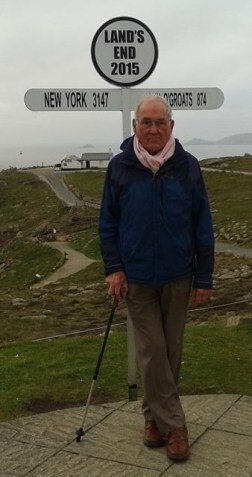 With my dad at Land’s End
With my dad at Land’s EndI’ve often thought that if I lived on continental Europe, I’d be tempted to drive as far as I could before the car conked out. I could leave my home in say, Paris, and keep going until I reached Hong Kong, just for the hell of it. People have done stranger things.
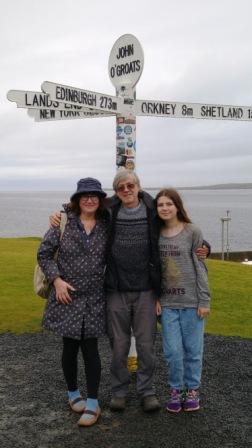 Going to the opposite extreme With my husband and daughter at John O’Groats
Going to the opposite extreme With my husband and daughter at John O’GroatsSo when I was in Mid-Wales last month, on the platform of Devil’s Bridge, the last stop on the Rheidol Steam Railway’s scenic twelve-mile line from Aberystwyth, I was captivated by a stylish retro railway poster with a similar sentiment.
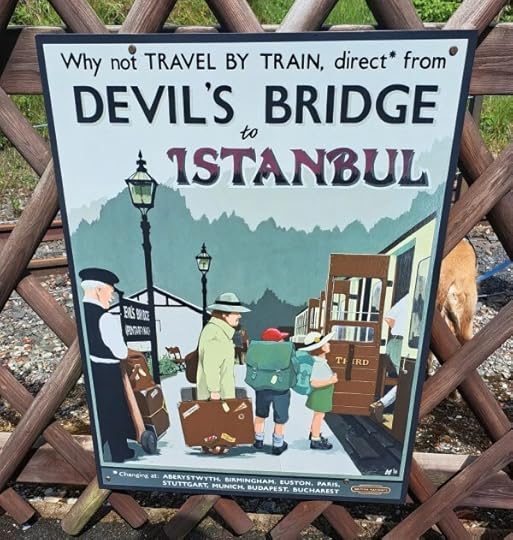
Above an image of a family boarding an old-fashioned slam-door train was this slogan: “Why not travel by train direct* from Devil’s Bridge to Istanbul?” The asterisk at the bottom of the poster qualified this suggestion: “*Changing at Aberystwyth, Birmingham, Euston, Paris, Stuttgart, Munich, Budapest, Bucharest”. I was so tickled by the idea that I bought a postcard of the design in the station shop to pin over my desk for inspiration.
On returning home, I was only slightly disappointed to discover it wasn’t a genuine vintage advertisement, but a whimsical bit of fun by local artist Ag Cain. Still, you can’t fault his logic. And they do say Istanbul is lovely at this time of year…
This post was originally written for the June 2023 issue of the Hawkesbury Parish News .
Further Reading About AberystwythI love Aberystwyth so much that after visiting it for the first time, I included it in my novella Mrs Morris Changes Lanes. It’s a fun, light read, a second-chance romantic comedy with a touch of magical realism. The beautiful cover design, hand-drawn by Rachel Lawston, shows Mrs Morris setting off on a mystery tour in a rather special purple Mini, on loan from her local garage.
To order the ebook or slim paperback online, click the image below, or place an order at your local bookshop.
[image error] [image error]
June 14, 2023
Catching Up with Covid
There’s never a good time to get Covid, but I was surprised to catch it for the first time just as the NHS tracking app expired.
With reduced immunity due to rheumatoid arthritis and asthma, I’m clinically vulnerable and have had every vaccine offered. When I phoned 111 for advice, they told me I qualified for anti-viral medication, which was only on my radar as something President Trump had been prescribed early in the pandemic. He’s not my usual role model, but given the alternative was “high risk of serious complications and death”, it was an offer I couldn’t refuse.
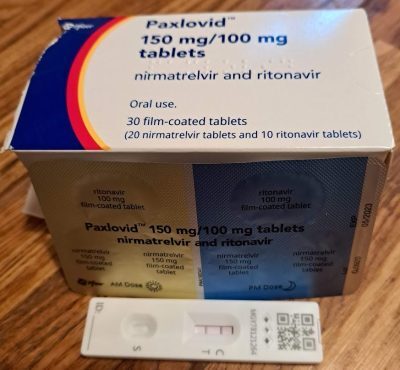 The neat, organised packaging of the Paxlovid made it more interesting to take – three tablets, morning and evening, from colour-coded blister-packs, with one of the tablets designed to make the others work better, apparently.
The neat, organised packaging of the Paxlovid made it more interesting to take – three tablets, morning and evening, from colour-coded blister-packs, with one of the tablets designed to make the others work better, apparently.The Latinesque name of the drug, Paxlovid, made it sound more appealing, suggesting a treatment involving peace and love. The small print explained the drug’s action in more combative terms: it targets the virus in my bloodstream to stop it replicating. I pictured a medical team in a submarine, miniaturised and injected into my veins, as in the 1960s cult sci-fi classic, Fantastic Voyage.

That may not be quite how Paxlovid works, but I’m pleased to say it hastened my recovery, and I escaped without the classic cough or fever that characterised early Covid cases. However, I’m still not back up to my normal speed.
Some days I feel like an old 78 record playing at 16rpm.
The experience taught me three things I’d like to share in case they help any readers in a similar position.
Covid is a chameleon. For the first few hours, it fooled me into thinking I had either hay fever or an allergic reaction to carpet dust in our bell ringing tower. Sneezing and bell ringing are not a good mix. Only when flu-like pains woke me through the night did I realise it was something more serious. A positive Covid test next morning confirmed my fears.I’m a dolt for not realising this sooner: testing negative doesn’t mean you’re better. The helpful 111 medic advised me to retest five days after testing positive. I felt so ill that I almost didn’t bother, but I obeyed her anyway. Result: negative. Although I wasn’t fit for bell ringing or anything else for a while, it was of psychological benefit to know I was no longer a public health hazard.Covid changed my perception of time. When healthy, my default is to do everything at high speed (except drive, you’ll be relieved to hear). While unwell, what usually takes me minutes took hours. Meanwhile, the clock kept whizzing round. Unable to believe three hours had gone by in what felt like 15 minutes, I checked the battery, assuming it had expired 21 hours before.While the clock was working perfectly, recharging my own battery is going to take time. But what better excuse to spend June resting in the garden, watching my husband do all the work? There’s a first time for everything, not only for Covid.
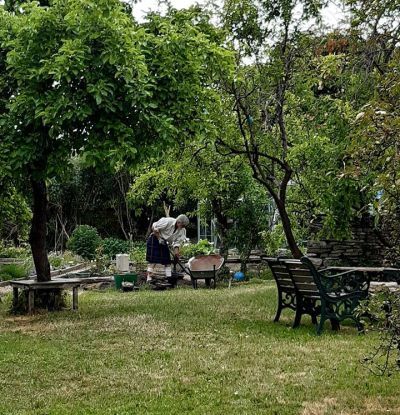 My Scottish husband Gordon, gardening in his kilt (as you do…)
My Scottish husband Gordon, gardening in his kilt (as you do…)This post was originally written for the June 2023 issue of the Tetbury Advertiser.
Like to read more of my columns from the Tetbury Advertiser?I’ve been writing short, pithy columns for this award-winning Cotswold magazine since 2010, and so far there are two collections of my Tetbury Advertiser columns available in ebook and paperback formats, Young By Name and Still Young By Name. Click the cover images below to order your copies online, or request them from your local bookshop. The rural images on the covers were painted in watercolours by my talented father,
[image error] [image error]
June 7, 2023
Why My Heart is in the Highlands
This post was originally written for my publisher, Boldwood Books, to use on the launch of my eighth Sophie Sayers Cozy Mystery, Murder in the Highlands, in March 2023.
When I first visited the Highlands in 2000 with my new Scottish boyfriend, I couldn’t understand how at the age of 19 he had torn himself away from such a beautiful country to live in England. Although he came from Bannockburn, the site of the famous 1312 battle in Central Scotland at which the Scots thrashed the English, Gordon’s heart was in the Highlands, as the Robert Burns poem goes.
Specifically, Gordon was an aspiring Munro bagger. He had embarked on the very Scottish quest of climbing all 282 Scottish mountains over 3000 feet high, named after Sir Hugh Munro who’d first listed them all in 1891.
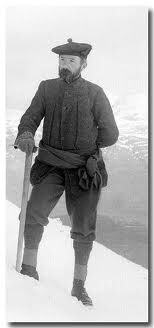 The namesake of Hector Munro in the Sophie Sayers series – pioneering climber and hillwalker Sir Hugh Munro
The namesake of Hector Munro in the Sophie Sayers series – pioneering climber and hillwalker Sir Hugh MunroEvery summer holiday for the next twenty years, touring in various camper vans, we headed north of the border so that he could gradually tick them off his list. I was the designated driver of this support vehicle, dropping him off at the starting point for each mountain and picking him up many hours later at his designated finishing point.
 Our camper van, precariously parked outside Linlithgow Palace, near Edinburgh
Our camper van, precariously parked outside Linlithgow Palace, near EdinburghMeanwhile I’d take myself off for the day to explore. After a couple of years, our baby daughter came too. Over the years, we enjoyed many local attractions, including museums of Highland life (one of which inspired the museum featured in Murder in the Highlands), spectacular beaches, steam train rides (think Harry Potter) and loch cruises (one of these is in the new book too).
 I send Sophie and Hector to some of my favourite places in the Highlands, including Loch Ness
I send Sophie and Hector to some of my favourite places in the Highlands, including Loch NessAlthough I’m no climber, I have seen more of the Highlands than many Scots. I’ve grown to love their rugged, raw scenery; the pure, bracing air; the soft colours and hard rocks of the mountains and rolling moors.
In the Highlands, I feel closer to nature, to history and to prehistory than anywhere else I’ve ever been. There’s a primeval quality to much of the scenery, and in some places the landscape is lunar.
 In Glencoe, one of my favourite parts of the Highlands (with essential waterproof Scottish hat!)
In Glencoe, one of my favourite parts of the Highlands (with essential waterproof Scottish hat!)The space and isolation in this sparsely populated territory provide peace and tranquility, but also a sense of danger and excitement.
 Near Ben Cruachan
Near Ben CruachanThe relative isolation as you travel brings you closer to your travelling companions, so where better to send Sophie and Hector to take their relationship to the next stage, especially as her parents live in Inverness?
To be honest, I planted them there at the start of the series, thinking it could be a great setting for a later installment.
As to my Scotsman – reader, I married him, in full Highland regalia.
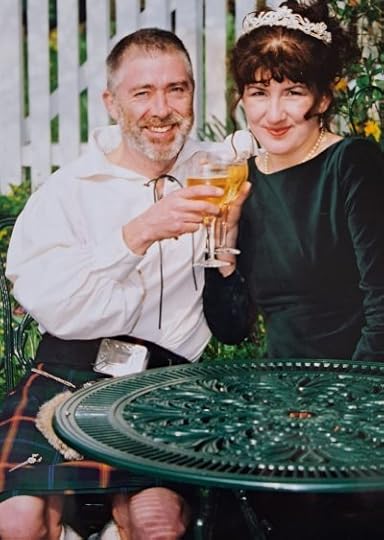
What was the outcome of Sophie and Hector’s romantic trip north of the border? You’ll have to read Murder in the Highlands to find out!
NEW!SPECIAL OFFERS FOR MURDER IN THE HIGHLANDS
Since it was published in March, Murder in the Highlands has gained over 200 reviews from around the world on Amazon, with a 4.4* average. Huge thanks to everyone who has read and reviewed it so far.
If you haven’t yet read it, here are two special offers currently running on the book:
Offer 1) 99p ebook (8th June only)For a very short time, on Thursday 8th June, readers in the UK, Canada and Australia will have the chance to nab the ebook at a bargain price of 99p or 99c. (With apologies to readers in other regions – those are the only territories BookBub chose for the promotion!)
Offer 2) Free in Amazon Prime (for three months)
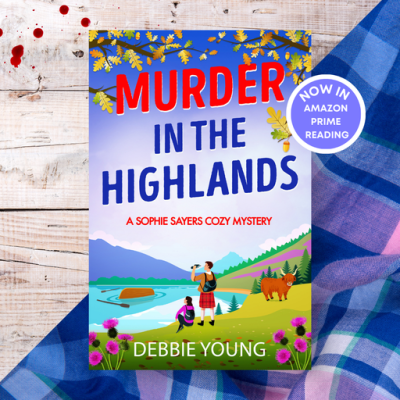
Alternatively, if you’re a member of Amazon Prime, wherever you are in the world, you can read the ebook for free, as the book has been picked for Amazon’s Prime Reading promotion for the next three months.
The book is also available in paperback, hardback and audio.
FOR MORE NEWS ABOUT MY BOOKS AND MY WRITING LIFETo receive Boldwood Books’ newsletter about my new books and special offers, click here.
To receive my newsletter about my writing life, click here (free ebook for all new subscribers).
May 24, 2023
Inspired by Stained Glass
In this week’s post, I’m interviewing my historical novelist friend Clare Flynn about her new historical novel, The Colour of Glass, which celebrates the art and craft of stained glass in a story set just before the First World War.
I’ve always loved stained glass, and for a long time making stained glass was one of my father’s hobbies. These days when I visit churches, stately homes or public buildings featuring stained glass, I take a special interest, whether it’s the ancient medieval kind, in modern abstract style, or anything in between.
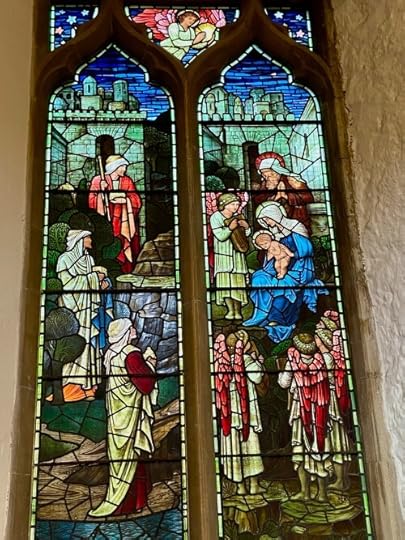 The Pre-raphaelite artist Edward Burne-Jones is one of my favourite stained glass artists – this is Clare Flynn’s photo of one of his windows from a church in Rye. (Photo: Clare Flynn)
The Pre-raphaelite artist Edward Burne-Jones is one of my favourite stained glass artists – this is Clare Flynn’s photo of one of his windows from a church in Rye. (Photo: Clare Flynn)I was therefore excited to learn that my author friend Clare Flynn was inspired by our writing retreat in the autumn of 2021 to set her next historical novel around an early 20th century stained glass artist. The resulting novel, The Colour of Glass, will be published on 1st June, and Clare’s joining me on my blog this week to tell me more about it.
Welcome, Clare! Can you please kick off by with a brief summary of your new novel.
 Clare’s new novel was inspired by our writing retreat at an Arts and Crafts house
Clare’s new novel was inspired by our writing retreat at an Arts and Crafts houseThe Colour of Glass tells the parallel stories of Alice Dalton, from an aristocratic family facing hard times, and Edmund Cutler, an apprentice stained glass artist, from a wealthy family keen to scale the social ladder. Both become estranged from their families. Edmund and Alice meet when she is briefly engaged to his brother, but their paths diverge. Five years later they meet again.
The book tackles themes of art, women’s suffrage, personal fulfilment, family conflict and parental expectations.
Why did you choose to write about stained glass?
The initial idea was quite random. I was “stuck” trying to write a different book and was staying with a group of writer friends – you included! – in an Arts & Crafts house. Lorna Fergusson opened a book off the shelf at random and read me some cues in the hope something would spark. One was “stained glass window”. The idea of an Arts and Crafts stained-glass artist intrigued me and I began to research it and fell in love with the craft.
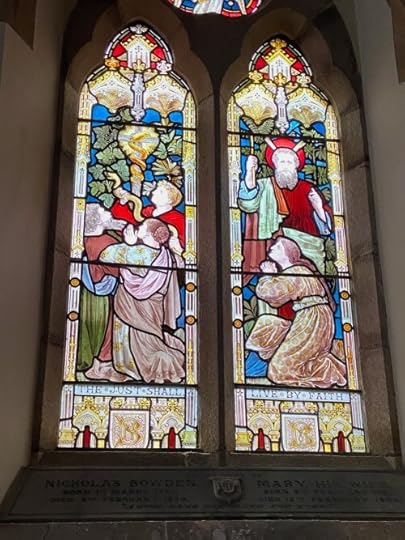 This panel is from All Saints’ Church in Marazion, Cornwall, just down the road from where Clare and I took part in another writers’ retreat in March.(Photo: Clare Flynn)
This panel is from All Saints’ Church in Marazion, Cornwall, just down the road from where Clare and I took part in another writers’ retreat in March.(Photo: Clare Flynn)How much did you know about stained glass before you started writing, and how did you go about researching all you needed to know for your story?
Virtually nothing. I’d had no interest in it at all. But as soon as I started digging I was hooked.
I went to stay in a hotel that had a former chapel in its grounds with the most magnificent windows I’d seen in years – made by the Irish artist Harry Clarke. I bought two magnificent and lavishly illustrated books – one on Harry and the other a comprehensive study of Arts and Crafts stained glass. Soon I came across Christopher Whall, the most renowned A&C stained glass artist. I tracked down a speech he gave in Liverpool and then a wonderful handbook he wrote explaining everything a student or apprentice would need to know. Christopher had to go in the book!
That led me to the Central School (now Central St Martins) where Whall taught as did Karl Parsons, also mentioned in the book. The school then was in Southampton Row, Holborn, and I managed to track down the floor plans. I also watched videos online on glass craft.
 Stained glass window by Harry Clarke (Photo: Clare Flynn)
Stained glass window by Harry Clarke (Photo: Clare Flynn)What surprised you most about the world of stained glass artists?
Before I got into this, like my character, Alice, I’d believed it was about cutting up and sticking together bits of coloured glass. But the true craftsmen achieve all kinds of effects by painting, acid etching, using different types of glass and many other techniques.
I’d also been rather dismissive of it – just old saints in dusty churches – but soon discovered how rich were the imaginations of some of these artists and how talented they were at their craft.
I loved the way it was a fusion of artistry with craft in a way that’s probably not true of a lot of artforms.
To what extent are your characters in this book based on real people?
The main characters are all entirely invented but there are walk-on parts for several real people including Christopher Whall.
Stained glass is clearly a very old art – why did you pick the Edwardian era for your story?
As I mentioned above, I started writing it while staying in Goddards, an Arts and Crafts house in Surrey. It felt as though all the pieces came together. I based Bankstone, the house in the second part of the book on Goddards. I also love that period. The joyous innocence of it just before the horrors of the First World War are unleashed has always struck me as incredibly poignant.
You’ve clearly become very engrossed in the world of stained glass – are you tempted to write about any other period or aspect of it? You’re an accomplished painter – are you tempted to try your hand at this medium?
I’m not tempted to write about Medieval glass – much as I admire it. I’m very much a twentieth-century writer. It’s kind of you, Debbie, but I certainly wouldn’t claim to be an accomplished painter! More of a dabbler. But, yes, I’d be tempted to give stained glass a go.
 Stained glass window in Winchelsea (Photo: Clare Flynn)
Stained glass window in Winchelsea (Photo: Clare Flynn)What makes stained glass particularly interesting to write about – is it an art or a craft or a blend of both?
It’s exactly the fact that it’s a perfect blend of both. Until Christopher Whall came along most stained glass artists would hand over their cartoons to glass manufacturers to make. Whall was horrified at what he perceived as the butchery of his design and set about learning every single step so he could handle the entire process himself. Naturally, my Edmund, as his pupil, did the same. One of the contemporary specialists I have been following via YouTube and their newsletters also deal with every single aspect.
Where does this book fit into the canon of the rest of your work? – it made me think particularly of Letters from a Patchwork Quilt , which was the first book of yours that I read.
Interesting! That book was about a poet rather than an artist, but like Edmund, the main character, Jack, is a very driven man who makes some life-changing mistakes with the best of intentions. I love writing about art so perhaps there’s a fit with Jasmine in Paris and A Painter from Penang – oh and Kurinji Flowers. All of those involved painting, whereas The Colour of Glass required me to learn about a completely new medium for me. Many of the characters in my books tend to be involved in some form of artistic, musical or literary endeavour. I suppose it’s also a counterpoint to The Gamekeeper’s Wife and A Greater World, both of which are set in the period immediately after the First War. (Find out more about all of Clare’s books on her website at www.clareflynn.com.)
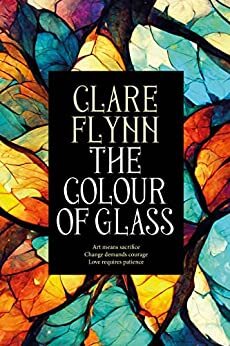 The cover for this book is quite different from that of your previous novels. Where does the image come from – is it a real piece of stained glass somewhere?
The cover for this book is quite different from that of your previous novels. Where does the image come from – is it a real piece of stained glass somewhere?
Jane Dixon-Smith, my designer found it. No idea where it’s from but I love the colours. I wanted to try a completely different approach. I was also trying to avoid religious imagery as while much stained glass is ecclesiastical there’s a risk if it’s on the cover that readers may think the book is religious. We shall see if it works! So far people seem to love it.
Once you start noticing stained glass, you realise just how much there is of it surviving from a very long period in history – what’s your favourite period/ aspect/application of stained glass?
There’s nothing to compare with the scale and majesty of the Medieval windows and it’s incredible to imagine what must have been involved then when they were literally inventing the techniques as they went along. Anyone whose been to Chartres, Notre Dame, or York will know exactly what I mean. But I can also marvel at the quirky intensity of Harry Clarke’s work – or that of Marc Chagall.
The great thing about it though is that you can walk into what might otherwise be an insignificant parish church in a village and find stunning examples. It’s great to get up close so you can actually see the paint strokes and effects.
Another key theme of this novel is feminism in the era of the campaign for women’s suffrage – how were female artists of that era affected by the politics of the age?
Many artists were in the front line of the suffrage movement. I mention one in the book: Mary Lowndes established a glass studio, Lowndes and Drury, and made numerous outstanding stained glass windows – she was also responsible for producing posters and propaganda for the suffrage movement and was the founder of the Artists Suffrage League and became leader of the National Union of Women’s Suffrage Societies.
Arts and Crafts stained glass has a good representation of women – including also Whall’s daughter.
The Colour of Glass ends as the First World War begins – what’s next for your characters, and how will the war and its aftermath change their relationship and the challenges that they face?
Aha! You can’t expect me to give that away! Suffice to say I am about 25k words into a follow up so watch this space!
Thank you so much, Clare, and best of luck with the launch of your new book on 1st June!
Like to read The Colour of Glass by Clare Flynn?
Click the image below to pre-order an ebook of The Colour of Glass now via Amazon UK.
Also available on Amazon stores worldwide.
The paperback will be available from 1st June.
May 20, 2023
New Novel, New Cover – and a Peek into the Design Process
This post introduces the cover of my next novel and shares the story of my long-term working relationship with its cover designer Rachel Lawston.
I’m delighted to share Rachel Lawston‘s new cover design for my next novel, Artful Antics at St Bride’s. This fourth book in my Gemma Lamb Cozy Mystery series will be published by Boldwood Books on 29th July, and the ebook is already available to preorder online. To whet your appetite, here’s the official blurb:
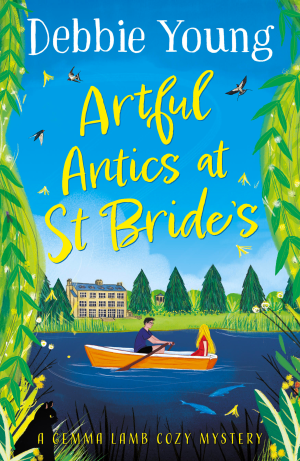 When English teacher Gemma Lamb’s school flat is wrecked by storms, maverick headmistress Hairnet insists the girls must fund its repair by setting up their own businesses – the start of a series of hilarious unintended consequences.
When English teacher Gemma Lamb’s school flat is wrecked by storms, maverick headmistress Hairnet insists the girls must fund its repair by setting up their own businesses – the start of a series of hilarious unintended consequences.
Meanwhile Gemma’s worries are compounded by the arrival of bossy new girl Frieda Ehrlich, sponsored by a mysterious local tycoon whose wealth is of dubious origins. Fearful for the school’s reputation, Gemma recruits an old friend to help investigate the tycoon’s credentials, jeopardising her romance with sports teacher Joe Spryke.
What is Frieda hiding? Why is her sponsor living in a derelict manor house? Why is his chauffeur such a crazed driver? And what has become of McPhee, Hairnet’s precious black cat? With a little help from her friends, Gemma is determined to solve these mysteries, restore her flat and save the school.
For anyone who loved St Trinian’s – old or new – or read Malory Towers as a kid. St Brides is the perfect read for you!
Each book in this series, set in an English boarding school for girls, takes place over half a school term, and this story runs from late February until the school breaks up for Easter.
For those unfamiliar with the English school system, the academic year begins in September, and we have three terms each year:
Autumn, from September to DecemberSpring, from January until EasterSummer, from Easter until JulyI like the optimism that refuses to designate any of the terms as Winter, even though we have decidedly wintry weather in the autumn and spring.
Here are all four covers for the series so far, which as you can see clearly convey the season for each story, thanks to Rachel Lawston‘s beautiful designs:
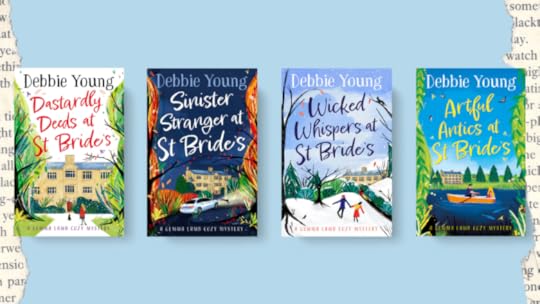
Book design is a very specialised art. It’s not just about coming up with a relevant picture and adding the book’s title and the name of its author. There are all kinds of subtleties to be considered, for example:
With so many books these days book online, the cover design must work just as well at “thumbnail” size, ie the size it’s displayed on the book’s page on any online retail site, as well as making anyone who sees it displayed in a physical bookshop want to pick it up, flip it over and read the blurb on the back cover – on the critical path to buying a copy.The design must create the right expectations in the reader by complying with the current trends for the genre, while making it stand out as being individual and memorable.The spine and the back cover must integrate with the front cover design – these are all important persuaders to browsers, and with most books in physical shops displayed spine outwards rather than showing the whole cover, the spine artwork needs to encapsulate the messages on the cover.Book designers understand and comply with these and other constraints in a way that more generalist designers, eg of brochures or advertising hoardings, would not be able to do. That’s why it’s crucial that publishers pick a book design specialist.
What many readers don’t realise is that book designers are not expected to read a book before designing its cover. They simply don’t have time. Therefore it’s down to the publisher to provide an appropriate brief, to which the book designer adds their own creativity and specialist knowledge.
My Partnership with Book Designer Rachel Lawston Rachel Lawston, author, artist and book designer
Rachel Lawston, author, artist and book designerI first started collaborating with Rachel back in 2017, when I self-published my first novel, Best Murder in Show, the first Sophie Sayers Cozy Mystery.
As an indie author, I was responsible for commissioning all my cover designs – a task that in traditional publishing is taken care of by the publisher rather than the author. This meant creating a brief of my ideas for the cover, including my likes and dislikes, and then responding to Rachel’s interpretation of the brief, which would include ideas of her own.
It’s really important for the publisher (whether an indie author or a traditional publishing company) respects the designer’s ideas and remains open-minded, as they might come up with something quite different than expected. The best designers often come up with something much better and more exciting than the brief, but if the publisher/indie author disagrees, they work together to arrive at the best solution. For Artful Antics at St Bride’s, Rachel came up with a scene featuring the two central characters, Gemma and Joe, in a rowing boat on the school’s lake, which didn’t actually happen in the original story, but I liked the cover so much that I changed a scene where they are in conversation on a bench by the lake to putting them in a rowing boat, and I’m sure it’s a better scene now!
When you’re self-publishing, the buck for all aspects of the book, including the cover design stops with you, and it’s a big responsibility to make the right decisions. Great covers do sell more books, and a bad one can make the most brilliantly written books fail. It can therefore be an anxious moment when the email lands in your inbox bearing your designer’s draft visuals.
However, I was so delighted with what Rachel did for the first book, and so enjoyed the process of working with her, that I asked her to create the covers for both my series of mystery novels, and also for my series of novelettes in the Tales from Wendlebury Barrow series:
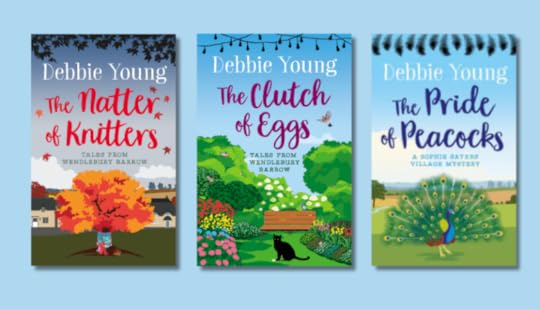
(If you’ve joined my Readers’ Club, you’ll recognise the one of the far right as the free ebook I send you when you sign up. If you haven’t got your copy yet, you can sign up here.)
Readers were constantly telling me how much they loved the covers, and I was very proud of how they looked. At least some of the many sales will have been made because readers were falling in love with Rachel’s designs!
Then two summers ago, on a whim, I wrote a novella that was unrelated to any of those series: a second-chance romantic comedy with a touch of magical realism, called Mrs Morris Changes Lanes. Although Rachel was by now incredibly busy (not least because I kept recommending her to all my indie author friends!), she found time not only to produce a cover, but to hand-draw it for me.
You may not know that most commercial covers use as their starting point stock images, for which the designer licenses the rights, before combining and manipulating them to create unique and appropriate covers for their particular project.
Having unique, original, custom-drawn covers is a privilege usually reserved only for top-selling authors.
So you can imagine my surprise and delight when Rachel sent me this beautiful hand-drawn design, which perfectly captured the impression I wanted of a slightly magical purple Mini driving into the unknown down a Cotswold lane in May. I couldn’t have been more thrilled.
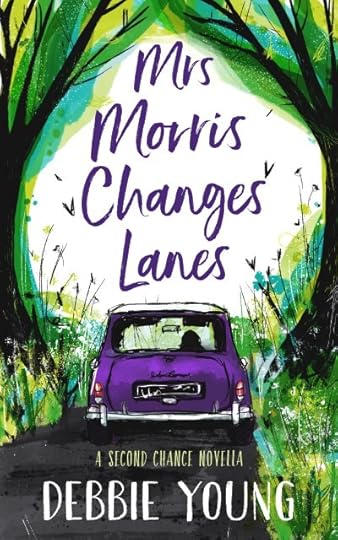
When I licensed the rights for all my novels to Boldwood Books in a 13-book contract a year ago, they naturally wanted to commission new designs to reflect their house style and commercial expertise, and I wasn’t looking forward to leaving Rachel’s covers for my novels behind. So it was a wonderful surprise when my editor told me that she’d worked with Rachel before, loved what she’d done for Mrs Morris Changes Lanes, and wanted to commission her to create a whole new set of hand-drawn covers for my St Bride’s series, which Boldwood planned to rename and rebrand as the Gemma Lamb Cozy Mysteries).
While my novels are doing really well in their new guise, I’m continuing to self-publish Mrs Morris Changes Lanes, and also my Tales from Wendlebury Barrow series, using Rachel’s original covers. You can buy all my books as ebooks and paperbacks online, or order them from bookshops if you prefer. The novels are also available in audio, hardback and large print.
Designer Turns AuthorIn the meantime, Rachel has established a new strand to her career as a highly-regarded author of children’s books about the environment, which is one of Rachel’s great passions. in her spare time she is an education volunteer at WWT London Wetland Centre in Barnes, helping children discover nature. Rachel’s love of the natural world has always shone through in her designs for my books too.
Here are all her own books so far, all published by Pikku Publishing and illustrated by Lisa Visirin and Beatriz Castro:
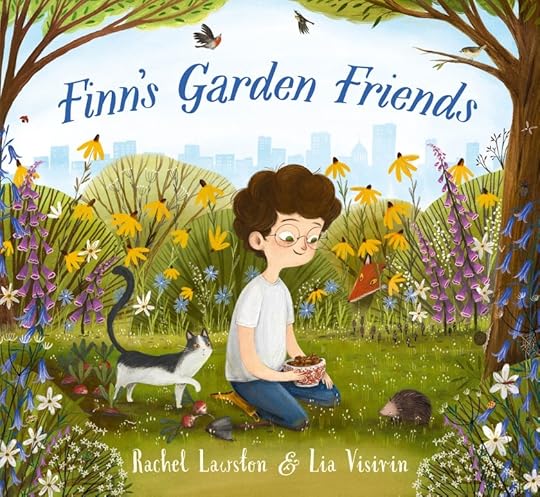

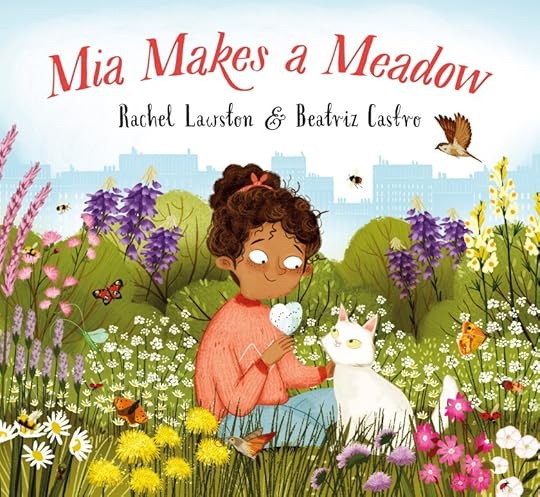
Rachel’s beautiful picture books make perfect gifts for young nature lovers, whether they live in the town or the country. The books have won prizes and accolades from the likes of Chris Packham and the RSPB, and are on sale at environmental tourist attractions as well as in bookshops and online. Rachel has also gained many young fans with visits to schools and children’s literature festivals.
Rachel’s latest venture as an author is a children’s book written jointly with her husband Paul Lawston, Learning Manager at the London Wetland Centre and Environmental Education Consultant to publishers. Paul also very kindly checked the details about birds in my novelette, The Clutch of Eggs.
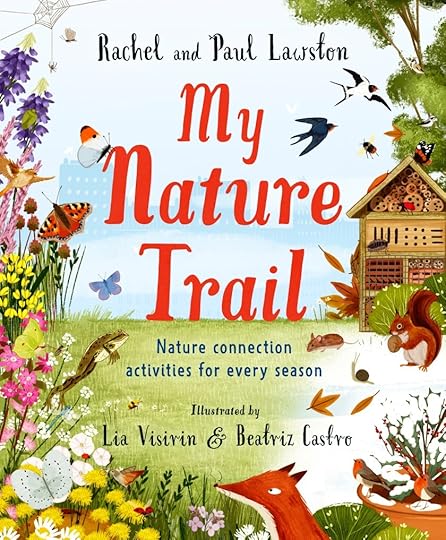
My Nature Trail will also be published by Pikku Publishing in October, and I can’t wait to read it!
For More Information about Rachel LawstonTo find out more Rachel, visit her websites:
www.lawstondesign.com for information about her design serviceswww.rachellawston.com for news about her books
May 10, 2023
My Talk from the HULF Festival of Words: School Story Slang – with Molesworth, Jennings, the Chalet School and St Bride’s
I don’t usually speak from a script at lit fests, but as I had just had Covid when the HULF Festival of Words* came around, I didn’t want to rely on my slightly fuzzy memory. Having written the script for my affectionate talk about the use of slang in school stories, I hung on to it, so that I could share it with you today here on my blog.
*HULF is the Hawkesbury Upton Literature Festival, which I founded in my home village in 2015, and which has been running public events in various venues about the parish ever since.
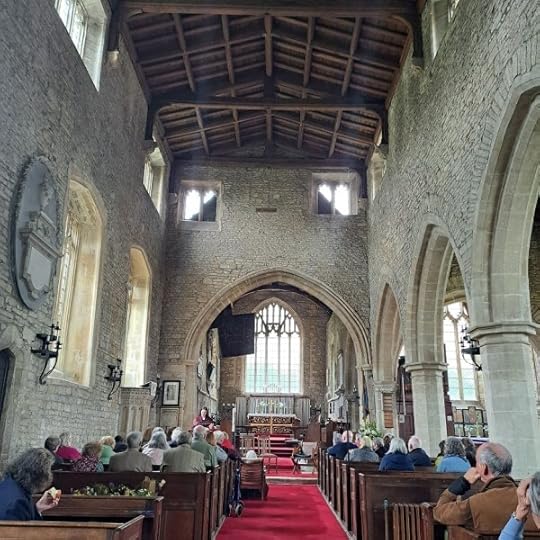 The inspiring setting for our HULF Festival of Words last month
The inspiring setting for our HULF Festival of Words last month(My talk followed the one by Colin Dixon, Tower Captain of the bell ringers of St Mary’s, Hawkesbury, who fascinated us with the colourful Language of Bells.)
Having taken up bell ringing with Colin, I know from first hand that learning the jargon that goes with bell ringing gives you a sense of camaraderie with your fellow bellringers. I’m going to talk now about shared jargon or slang in a different peer group – that of schoolchildren in a school setting.
Slang is especially important for young people in their formative years at school – all the more so if your school takes you away from home, so that during term time at least, school is your home.
Early in their history, boarding schools developed their own brand of slang – in particular, boys’ schools, because for many years there were no girls’ boarding schools. Because so many of them were hotbeds of the Classics – and perhaps also because it sounded impressive – much of this slang derived from Latin, so that the term for a short holiday is an exeat, the subjunctive of exit, meaning “Let him go away”. Winchester’s masters, are called dons, from dominus, Latin for master. (The most traditional public schools don’t call their staff teachers – they’re all masters or mistresses.) Eton’s dames – their word for matrons or housemistresses – comes from the Latin domina. A swot is called a sap, which comes from the Latin sapiens, meaning to know. And so on.
The slang of the longest-established and most prestigious schools was often adopted by minor public schools and the latecomers, but some words remain the preserve of their originating school because they relate to local geography. In the days when boys spent a lot of time studying the Bible, which yielded useful source of nicknames. The stream running through the playing fields of Eton is known as Jordan, and the place where the boys washed at Winchester was called Moab, taken from line 8 of Psalm 60, “Moab is my wash-pot”.
Winchester College even has a word for its own slang: notions, and learning the Winchester Notions is a rite of passage for new pupils.
Those few examples give you a flavour of the endless list, and if you are hungry for more, there is a fabulous book from 1900 available to read for free online via the Gutenberg Project – The Public School Word Book by John S Farmer that runs to 100 pages. (Click here to read it online.)
As someone who worked for 13 years in what was then a girls’ public school, now co-ed, at Westonbirt, and who is writing a series of novels set in a fictitious girls’ boarding school, (of which the 4th will be published on 29th July, Artful Antics at St Bride’s, I have a special interest in boarding school slang. But my love of school slang goes back to my own childhood, when, educated in state day schools, I was reading stories about boarding schools.
Ah, Enid Blyton, you might be thinking – Malory Towers, St Clare’s, or even the more exotic Chalet School, set in the Austrian Tyrol.
Actually, I preferred books about boys’ boarding schools, in particular two series that had a very special slang of their own: Anthony Buckeridge’s Jennings and Geoffrey Willans’ Molesworth (memorably illustrated by Ronald Searle, also known for his cartoons of the girls’ boarding school, St Trinian’s.
Both authors had worked as schoolmasters in minor preparatory boarding schools and had witnessed at first hand how young boys wrangled and mangled the English language to serve their needs for self-expression.
I wanted to be in their gang. I wanted to call a good idea “a wizard wheeze”, and a terrible mistake “a massive bish”, as Jennings did, and to voice my indignation with a Molesworthian “chiz chiz chiz”.
If you’re already familiar with these characters’ creative approach to the English language, you’ll enjoy the passages I’m about to share, and if not, I hope these snippets will encourage you to try them – because you’re never too old to enjoy this schoolboy humour. Jennings was written for children of his age, reading as an adult you empathise with the masters. Molesworth, however, was written for adults, first appearing in Punch, and whatever age you are, it’s hard not to take his side.
Here’s an extract from Down with Skool, in which Molesworth considers the awful prospect of starting a formal education (the spelling is Molesworth’s own):
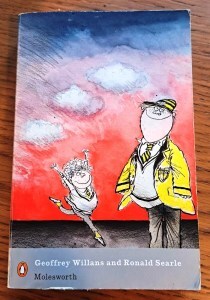 It seems strange that all the tuough boys around with faces like wild baboons started life as babes in prams chiz chiz chiz. I mean you kno wot weeds babes are they like about and gurgle and all the lades sa icky pritty and other uterly wet things.
It seems strange that all the tuough boys around with faces like wild baboons started life as babes in prams chiz chiz chiz. I mean you kno wot weeds babes are they like about and gurgle and all the lades sa icky pritty and other uterly wet things.
Being a baby is alright but soon all the boys who hav been wearing petticoats chiz chiz chiz begin to get bigger, they start zooming around like jet fights climb drane pipes squirt water pistols make aple pie beds set booby traps leave tools about the garden refuse to be polite to visiting aunts run on the flower beds make space rockets out of pop’s golf bag and many other japes and pranks.
It is at this time that parents look thortfully at their dear chicks and sa
IT IS TIME WE SENT NIGEL TO SKOOL.
CHIZ!
(Extract © Geoffrey Willans)
In the following extract from Jennings Goes to School, new pupil Jennings is trying to get to grips with the slang at Linbury Court Preparatory School:
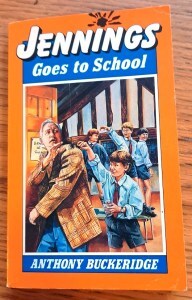 “I say, Venables, what’s that master’s name?”
“I say, Venables, what’s that master’s name?”
With an effort, Venables descended from the sublime to the ridiculous. “Were you talking to me?”
“Yes. That master. What did you say his name was?”
“That’s Benedick,” replied Venables. “We all call him that, anyway. Actually, his name’s Mr Carter.”
“Why call him something else?” demanded Jennings.
“Well, you heard him say grace just now. Benedictus and all that. And after meals, he says, ‘benedico, benedictata'”
Jennings waited in case more explanation was forthcoming, but it wasn’t.
“Go on,” he said.
“I’ve just told you,” said Venables, with the patience reserved for imbeciles. “Benedictus – Benedick Carter.”
“Oh,” said Jennings. “Is that a joke?”
“You’re a bit thick, aren’t you?” replied Venables.
(Extract © Anthony Buckeridge)
When I came to write my own boarding school stories, which are set in the 21st century, I had a different challenge to contend with: to make them credible, sadly, the pupils would have to swear. However, I write in a genre known as cozy mystery, which is meant to be family-friendly – no sex, no graphic violence, and no bad language – or else there will be complaints! So I came up with a workaround that is effectively a different kind of school slang, as you’ll see from this passage from the first in my school series, Dastardly Deeds at St Bride’s, in which Miss Gemma Lamb, the newly arrived English teacher, is being shown the ropes by her mentor, Miss Oriana Bliss, Head of Maths:
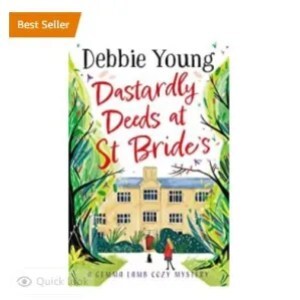 The first St Bride’s novel is currently topping the charts in the US Amazon store, and is available in ebook, audiobook and paperback worldwide
The first St Bride’s novel is currently topping the charts in the US Amazon store, and is available in ebook, audiobook and paperback worldwide
“I suppose swearing is against school rules,” I said.
“You’re right. It doesn’t stop them though. The girls swear in code instead. They think the staff haven’t rumbled it, but there’s a key to the code in the alternative prospectus secretly published by the sixth formers. We’ve had a copy in the staffroom for years.”
She led me around a corner to a long, dark corridor. “Rather cleverly, they’ve devised a system based on quaint expletives culled from school stories of yesteryear. ‘Blinking’, ‘cripes’, ‘flipping’ and so on sound innocuous until you discover they’re all paired with alliterative equivalents in the modern vernacular. When they say ‘blinking’, they’re thinking ‘bloody’. We turn a deaf ear to them callig each other a ‘flipping beast’ or whatever, until they slip up, double-compensating, and say the rea swear words by mistake. The other girls are genuinely shocked when that happens, and of course we staff have to pretend to be terribly cross.’
Like the pupils of St Bride’s, I think I’ve got away with it.
PS The day after the Festival, we had a guest preacher at the service in St Mary’s, the Reverend Tim Novis, who is Senior Chaplain at Marlborough College. When our vicar, the Reverend Richard Thomson, in his introduction, asked Tim whether he had a chaplain to help him at Marlborough, his reply was classic boarding school slang: “No, just eager beaks” (beaks means teachers – or masters, as public schools prefer to call them!)
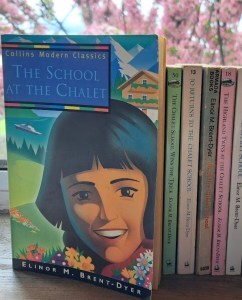 PPS A week after the Festival of Words, I was amused to discover on starting to read the second Chalet School story, Jo of the Chalet School, by Elinor M Brent-Dyer, first published in 1926, when the girls are banned from using slang such as “top-hole” and “ripping”, and told to read the classics to improve their language, they come up with an ingenious response. They become adept in the use of the slang in Shakespeare’s plays instead!
PPS A week after the Festival of Words, I was amused to discover on starting to read the second Chalet School story, Jo of the Chalet School, by Elinor M Brent-Dyer, first published in 1926, when the girls are banned from using slang such as “top-hole” and “ripping”, and told to read the classics to improve their language, they come up with an ingenious response. They become adept in the use of the slang in Shakespeare’s plays instead!
For more information about the Hawkesbury Upton Literature Festival, and to keep up with its future events, visit www.hulitfest.com.





